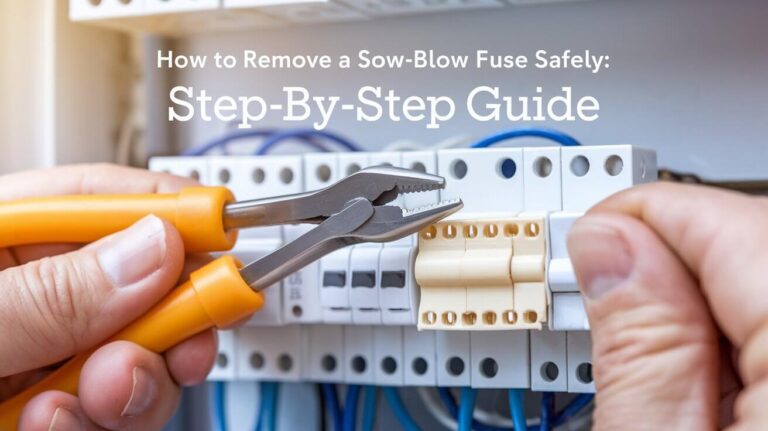How to Tell if a Car Fuse is Blown: A Complete Guide

Car fuses are small but vital components that protect your car’s electrical circuits. When a car fuse is blown, it often results in specific electrical functions (like headlights, power windows, or radios) no longer working. Knowing how to check and replace a car fuse can save time and prevent further electrical damage. In this guide, we’ll walk through everything you need to know to tell if a car fuse is blown, including steps for visual inspections, tools for testing, and tips for replacing and maintaining fuses.
What is a Car Fuse and Why Do They Blow?
Definition of Car Fuse
Car fuses are small devices designed to protect the electrical circuits in your vehicle. They interrupt the flow of electricity when the current exceeds a safe level, which prevents damage to the wiring and connected components. Most car fuses are made of a small wire that melts when it overheats, stopping the flow of electricity through the circuit.
Purpose of Car Fuses
Car fuses safeguard specific electrical components, such as lights, stereo systems, or window controls, from unexpected power surges or short circuits. Each fuse in a vehicle is assigned to a particular component or system. When a fuse blows, it disconnects the electrical current to that part of the car, keeping the rest of the electrical system safe.
Common Causes of Blown Fuses
- Electrical Overload: Overloading a circuit by using multiple devices or high-power devices can blow a fuse.
- Short Circuits: Damaged wires or a faulty component can cause short circuits, which lead to fuse blowouts.
- Old or Corroded Fuses: Fuses can weaken over time, becoming prone to blowing even under normal conditions.
- Incorrect Fuse Rating: Installing a fuse with a different rating than the one specified can cause overheating and failure.
Symptoms of a Blown Car Fuse
Signs of Failure in Electrical Components
One of the most common symptoms of a blown fuse is a sudden failure in one or more electrical components. Here’s what you might notice:
- Power Loss: Headlights, radio, or other devices may suddenly stop working.
- Burning Smell: A faint burning smell near the fuse box may indicate a blown fuse.
- Dashboard Indicators: In some cars, a “check fuses” indicator will light up.
Scenarios with Repeated Blown Fuses
If the same fuse blows frequently, this could be a sign of a deeper issue. For example, short circuits in wiring or overloaded circuits can cause repetitive fuse failures. Identifying these issues can prevent costly repairs down the line.
Identifying the Location of Car Fuses
Finding the Fuse Box
Fuse boxes are typically found in one of three main locations:
- Under the Hood: Often in the engine compartment near the battery.
- Under the Dashboard: Usually accessible from the driver’s side, under the dashboard.
- In the Trunk or Rear Panel: Some vehicles have fuse boxes in the trunk or behind interior panels.
Consult your vehicle’s manual to locate each fuse box.
Reading the Fuse Diagram
Each fuse box typically has a diagram showing which fuses correspond to which parts of the vehicle. Diagrams may be printed on the fuse box cover or included in the vehicle’s manual. For example, you might find that a specific fuse corresponds to the radio or interior lighting, helping you quickly identify the fuse associated with a faulty component.
How to Inspect and Identify a Blown Fuse
Visual Inspection
- Turn Off the Ignition: To prevent electric shock, always switch off the car before inspecting a fuse.
- Remove the Fuse Carefully: Use a fuse puller or needle-nose pliers to remove the fuse from the fuse box.
- Check for Physical Damage: Examine the fuse’s filament or wire. If it appears broken, melted, or has burn marks, the fuse is blown.
Using Diagnostic Tools
If the visual inspection is inconclusive, you can use a multimeter or test light to check the fuse.
- Testing with a Multimeter:
- Set the multimeter to the ohms setting.
- Place each probe on either side of the fuse. A good fuse should show near-zero resistance.
- If the reading is infinite, the fuse is blown.
- Using a Test Light:
- Connect the test light to a ground point in your car.
- Touch the tip of the light to both sides of the fuse. If the light illuminates on both ends, the fuse is good. If it only illuminates on one end, the fuse is blown.
Step-by-Step Guide to Replacing a Blown Fuse
Safety Precautions
Before replacing a fuse, follow these safety steps:
- Turn Off the Car: Make sure the ignition is off, and disconnect the battery if necessary.
- Use Proper Tools: A fuse puller or a pair of pliers can help remove and replace fuses safely.
- Ensure Correct Fuse Rating: Check the vehicle manual for the correct rating before installing a new fuse.
Removing the Blown Fuse
- Locate the blown fuse using the diagram on the fuse box.
- Use a fuse puller or needle-nose pliers to pull the fuse out gently.
Installing a New Fuse
- Check the Fuse Rating: Match the fuse rating to the one specified in the manual.
- Insert the New Fuse: Push the new fuse firmly into the slot.
- Test the Component: Turn on the ignition to check if the component now works.
What to Do if Fuses Keep Blowing Repeatedly
Identifying Deeper Issues
If fuses blow repeatedly, there may be an underlying problem:
- Short Circuits: Damaged or exposed wires may cause short circuits.
- Faulty Electrical Components: A defective motor or lighting unit can draw too much current, leading to a blown fuse.
- Overloaded Circuits: Using multiple high-powered devices on the same circuit may cause recurrent fuse failures.
When to Seek Professional Help
For recurrent fuse problems, it’s often best to consult a mechanic. Persistent electrical issues can stem from faulty wiring, damaged components, or incorrect modifications that need expert troubleshooting.
Types of Car Fuses and Their Characteristics
Common Fuse Types
- Blade Fuses: The most common type, with ratings typically ranging from 5 to 30 amps.
- Glass Tube Fuses: Found in older vehicles; these fuses are cylindrical and less common in modern cars.
- Main Fuses: Larger fuses typically located near the battery, protecting major systems from high current surges.
Specialized Fuses and Their Uses
Different fuses serve distinct purposes. For example, mini blade fuses are used for compact spaces, while high-amperage fuses protect heavy-duty systems like the alternator.
Preventative Tips to Avoid Blowing Fuses
- Regular Fuse Inspection: Check your fuses periodically for wear and tear, especially if you’ve been experiencing electrical issues.
- Avoid Overloading Circuits: Don’t plug too many high-powered devices into a single outlet.
- Always Use the Correct Fuse Rating: Replacing a fuse with a different rating than specified can damage the electrical components it protects.
Common Questions About Car Fuses
Can You Drive with a Blown Fuse?
Generally, you can drive with a blown fuse, but certain components like headlights or windshield wipers might not function, impacting safety.
How Much Does it Cost to Replace a Fuse?
Replacing a car fuse can be inexpensive if done on your own (often around $1-5 per fuse). If a professional is needed, labor charges may apply.
How Often Should Car Fuses Be Checked?
It’s a good idea to inspect your car fuses at least once a year, or if you notice any unusual electrical behavior.
Troubleshooting Electrical Issues Related to Fuses
Checklist for Fuse-Related Problems
- Verify all fuses and check for visual signs of damage.
- Test each fuse with a multimeter or test light to confirm its condition.
- Inspect related wiring and components to rule out other potential causes of electrical issues.
Exploring Non-Fuse Causes of Electrical Failures
If all fuses are intact, investigate other components like the battery, alternator, and wiring. Sometimes, these parts can mimic blown fuse symptoms when they malfunction.
Conclusion
Diagnosing and replacing a blown car fuse is a manageable task that can save time and prevent costly repairs. By following the steps outlined in this guide, you can safely inspect, test, and replace fuses while minimizing the risk of further electrical issues. Remember, regular inspection and proper maintenance of your car’s fuses can help keep your vehicle’s electrical system in top condition.




